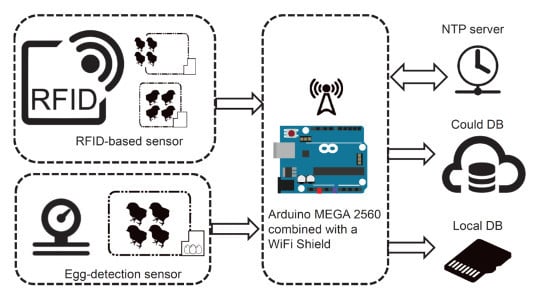An RFID-Based Smart Nest Box: An Experimental Study of Laying Performance and Behavior of Individual Hens
Abstract
:1. Introduction
2. Materials and Methods
2.1. Experimental Smart Nest Box
2.2. Experimental Housing System
2.3. Experiment Design
- Clean the coop and ensure the temperature and humidity were within the required range.
- Supply feed and water.
- Turn the light in the coop in the morning (06:00–09:00) and off in the evening (16:30–18:00).
- Collect the eggs in the egg-collection tube in the evening and record this number in laboratory record book.
- Check the console of the IoT platform to ensure that no exceptions occurred.
3. Results and Discussion
3.1. Analysis of Egg Yield and Weight
3.2. Nest Box Visiting and Laying Behavior
4. Conclusions
Acknowledgments
Author Contributions
Conflicts of Interest
References
- Gładkowski, W.; Kiełbowicz, G.; Chojnacka, A.; Gil, M.; Trziszka, T.; Dobrzański, Z.; Wawrzeńczyk, C. Fatty acid composition of egg yolk phospholipid fractions following feed supplementation of Lohmann Brown hens with humic-fat preparations. Food Chem. 2011, 126, 1013–1018. [Google Scholar] [CrossRef]
- Xin, H.; Gates, R.S.; Green, A.R.; Mitloehner, F.M.; Moore, P.A., Jr.; Wathes, C.M. Environmental impacts and sustainability of egg production systems. Poult. Sci. 2011, 90, 263–277. [Google Scholar] [CrossRef] [PubMed]
- Ruiz-Garcia, L.; Lunadei, L.; Barreiro, P.; Robla, I. A Review of Wireless Sensor Technologies and Applications in Agriculture and Food Industry: State of the Art and Current Trends. Sensors 2009, 9, 4728–4750. [Google Scholar] [CrossRef] [PubMed] [Green Version]
- Chen, H.; Xin, H.; Teng, G.; Meng, C.; Du, X.; Mao, T.; Wang, C. Cloud-based data management system for automatic real-time data acquisition from large-scale laying-hen farms. Int. J. Agric. Biol. Eng. 2016, 9, 106–115. [Google Scholar]
- Popović, T.; Latinović, N.; Pešić, A.; Zečević, Ž.; Krstajić, B.; Djukanović, S. Architecting an IoT-enabled platform for precision agriculture and ecological monitoring: A case study. Comput. Electron. Agric. 2017, 140, 255–265. [Google Scholar] [CrossRef]
- Siegford, J.M.; Berezowski, J.; Biswas, S.K.; Daigle, C.; Gebhardt-Henrich, S.; Hernandez, C.; Thurner, S.; Toscano, M. Assessing Activity and Location of Individual Laying Hens in Large Groups Using Modern Technology. Animals 2016, 6, 10. [Google Scholar] [CrossRef] [PubMed] [Green Version]
- Yao, L.; Sheng, Q.Z.; Li, X.; Gu, T.; Tan, M.; Wang, X.; Wang, S.; Ruan, W. Compressive Representation for Device-Free Activity Recognition with Passive RFID Signal Strength. IEEE Trans. Mob. Comput. 2018, 17, 293–306. [Google Scholar] [CrossRef]
- Cornacchia, M.; Ozcan, K.; Zheng, Y.; Velipasalar, S. A Survey on Activity Detection and Classification Using Wearable Sensors. IEEE Sens. J. 2017, 17, 386–403. [Google Scholar] [CrossRef]
- Subedi, S.; Pauls, E.; Zhang, Y.D. Accurate Localization and Tracking of a Passive RFID Reader Based on RSSI Measurements. IEEE J. Radio Freq. Identif. 2017, 1, 144–154. [Google Scholar] [CrossRef]
- Bu, K.; Li, Y. Every Step You Take, I Will Be Watching You: Practical StepAuth-Entication of RFID Paths. IEEE Trans. Inf. Forensics Secur. 2018, 13, 834–849. [Google Scholar] [CrossRef]
- Taylor, K.; Griffith, C.; Lefort, L.; Gaire, R.; Compton, M.; Wark, T.; Lamb, D.; Falzon, G.; Trotter, M. Farming the Web of Things. IEEE Intell. Syst. 2013, 28, 12–19. [Google Scholar] [CrossRef]
- Zaninelli, M.; Redaelli, V.; Tirloni, E.; Bernardi, C.; Dell’Orto, V.; Savoini, G. First Results of a Detection Sensor for the Monitoring of Laying Hens Reared in a Commercial Organic Egg Production Farm Based on the Use of Infrared Technology. Sensors 2016, 16, 1757. [Google Scholar] [CrossRef] [PubMed]
- Zaninelli, M.; Redaelli, V.; Luzi, F.; Bontempo, V.; Dell’Orto, V.; Savoini, G. A Monitoring System for Laying Hens That Uses a Detection Sensor Based on Infrared Technology and Image Pattern Recognition. Sensors 2017, 17, 1195. [Google Scholar] [CrossRef] [PubMed]
- Zaninelli, M.; Costa, A.; Tangorra, F.; Rossi, L.; Agazzi, A.; Savoini, G. Preliminary Evaluation of a Nest Usage Sensor to Detect Double Nest Occupations of Laying Hens. Sensors 2015, 15, 2680–2693. [Google Scholar] [CrossRef] [PubMed]
- Zaninelli, M.; Redaelli, V.; Luzi, F.; Mitchell, M.; Bontempo, V.; Cattaneo, D.; Dell’Orto, V.; Savoini, G. Development of a Machine Vision Method for the Monitoring of Laying Hens and Detection of Multiple Nest Occupations. Sensors 2018, 18, 132. [Google Scholar] [CrossRef] [PubMed]
- Burel, C.; Ciszuk, P.; Wiklund, B.S.; Brännäs, E.; Kiessling, A. Note on a method for individual recording of laying performance in groups of hens. Appl. Anim. Behav. Sci. 2002, 77, 167–171. [Google Scholar] [CrossRef]
- Thurner, S.; Wendl, G.; Preisinger, R. Funnel nest box: A system for automatic recording of individual performance and behaviour of laying hens in floor management. In Proceedings of the XII European Poultry Conference, Verona, Italy, 10–14 September 2006; pp. 610–611. [Google Scholar]
- Icken, W.; Thurner, S.; Heinrich, A.; Kaiser, A.; Cavero, D.; Wendl, G.; Fries, R.; Schmutz, M.; Preisinger, R. Higher precision level at individual laying performance tests in noncage housing systems. Poult. Sci. 2013, 92, 2276–2282. [Google Scholar] [CrossRef] [PubMed]
- Simultaneous Registration of Hens in Group Nest Boxes with a HF-Transponder-System to Evaluate the Laying Behavior. Available online: https://geoscience.net/research/033/398/033398053.php (accessed on 7 February 2018).
- Reiners, K.; Hegger, A.; Hessel, E.F.; Böck, S.; Wendl, G.; den Weghe, H.F.V. Application of RFID technology using passive HF transponders for the individual identification of weaned piglets at the feed trough. Comput. Electron. Agric. 2009, 68, 178–184. [Google Scholar] [CrossRef]
- Zaninelli, M.; Rossi, L.; Costa, A.; Tangorra, F.M.; Guarino, M.; Savoini, G. Performance of injected RFID transponders to collect data about laying performance and behaviour of hens. Large Anim. Rev. 2016, 22, 77–82. [Google Scholar]
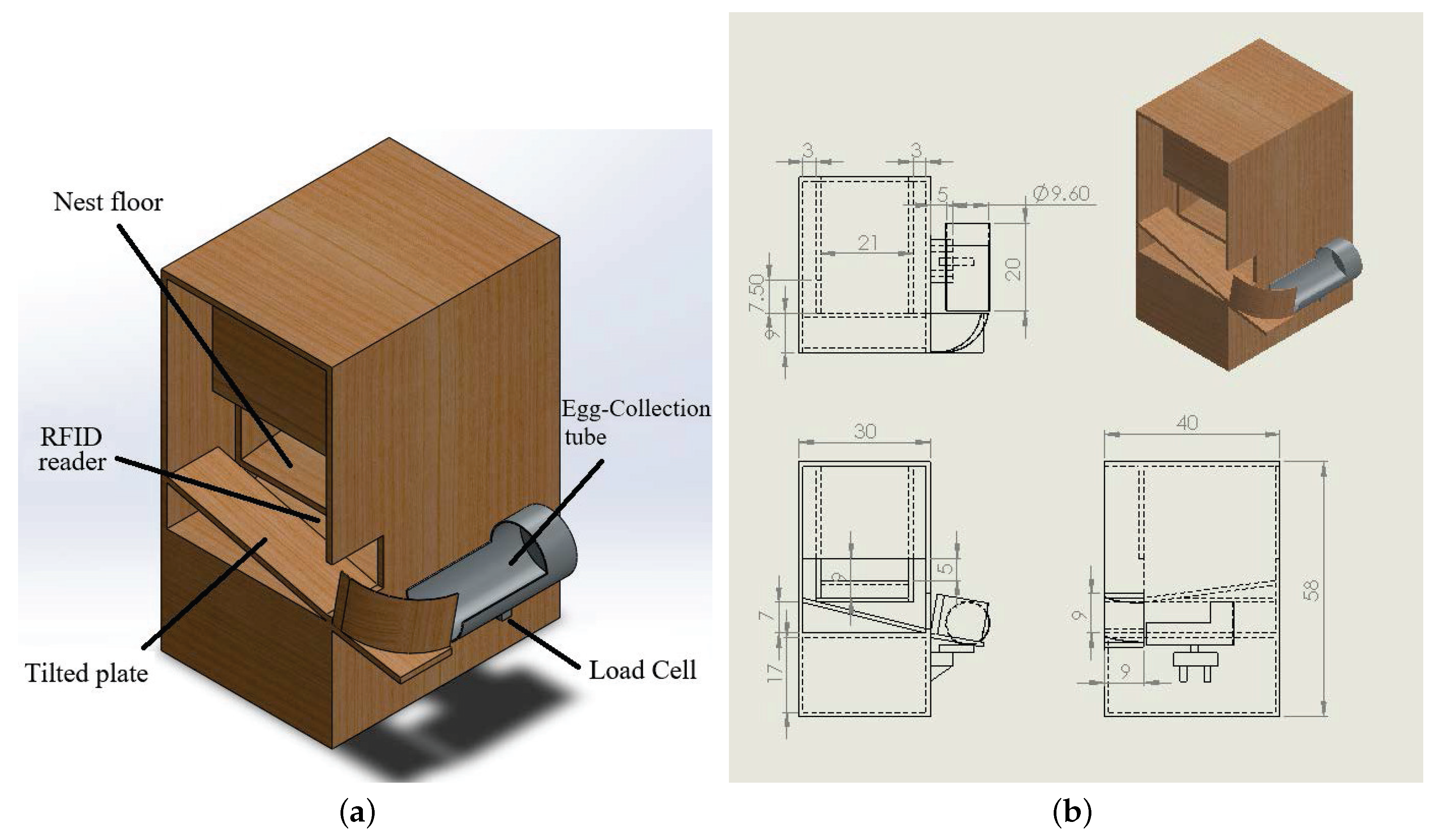
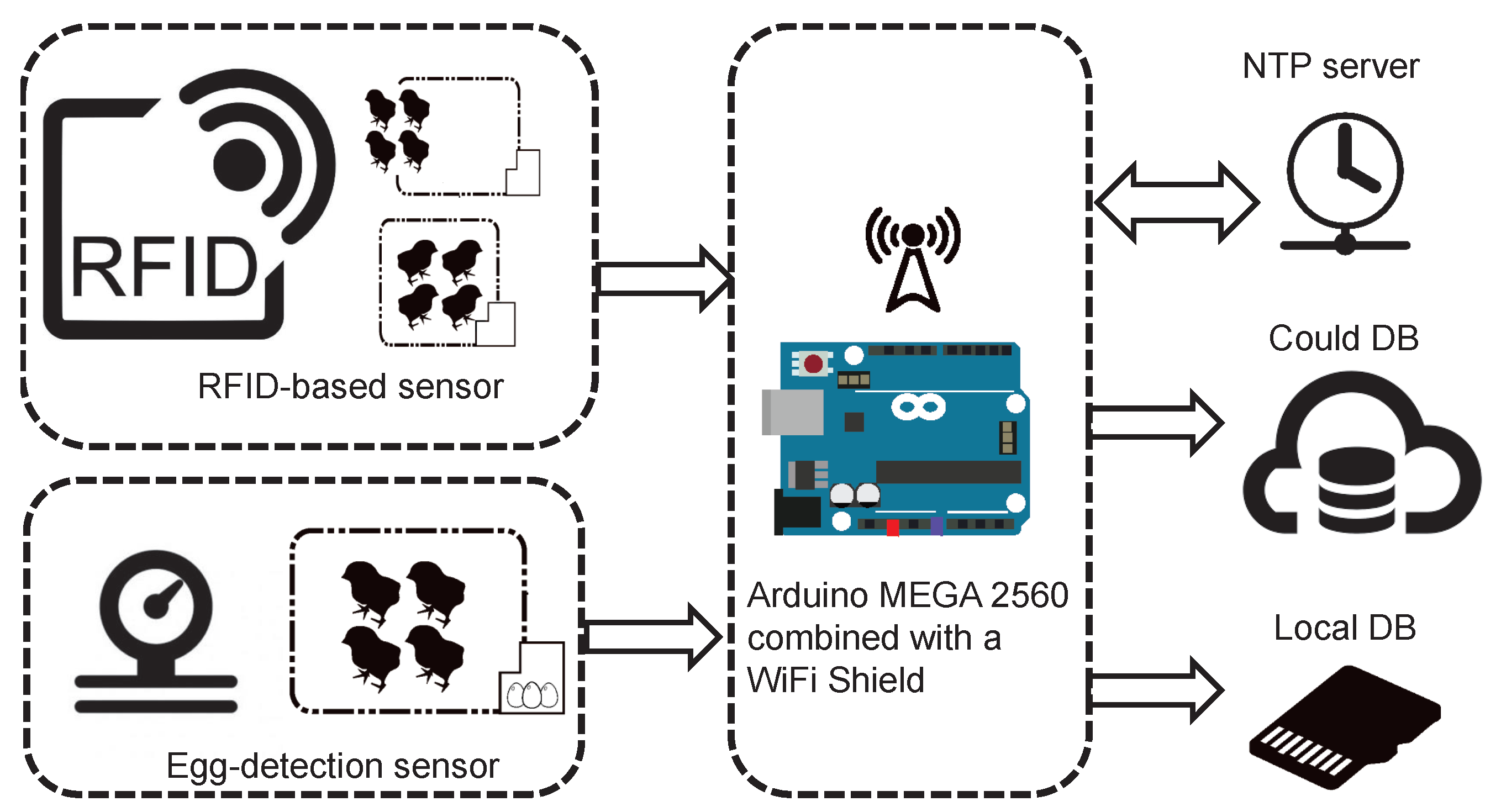
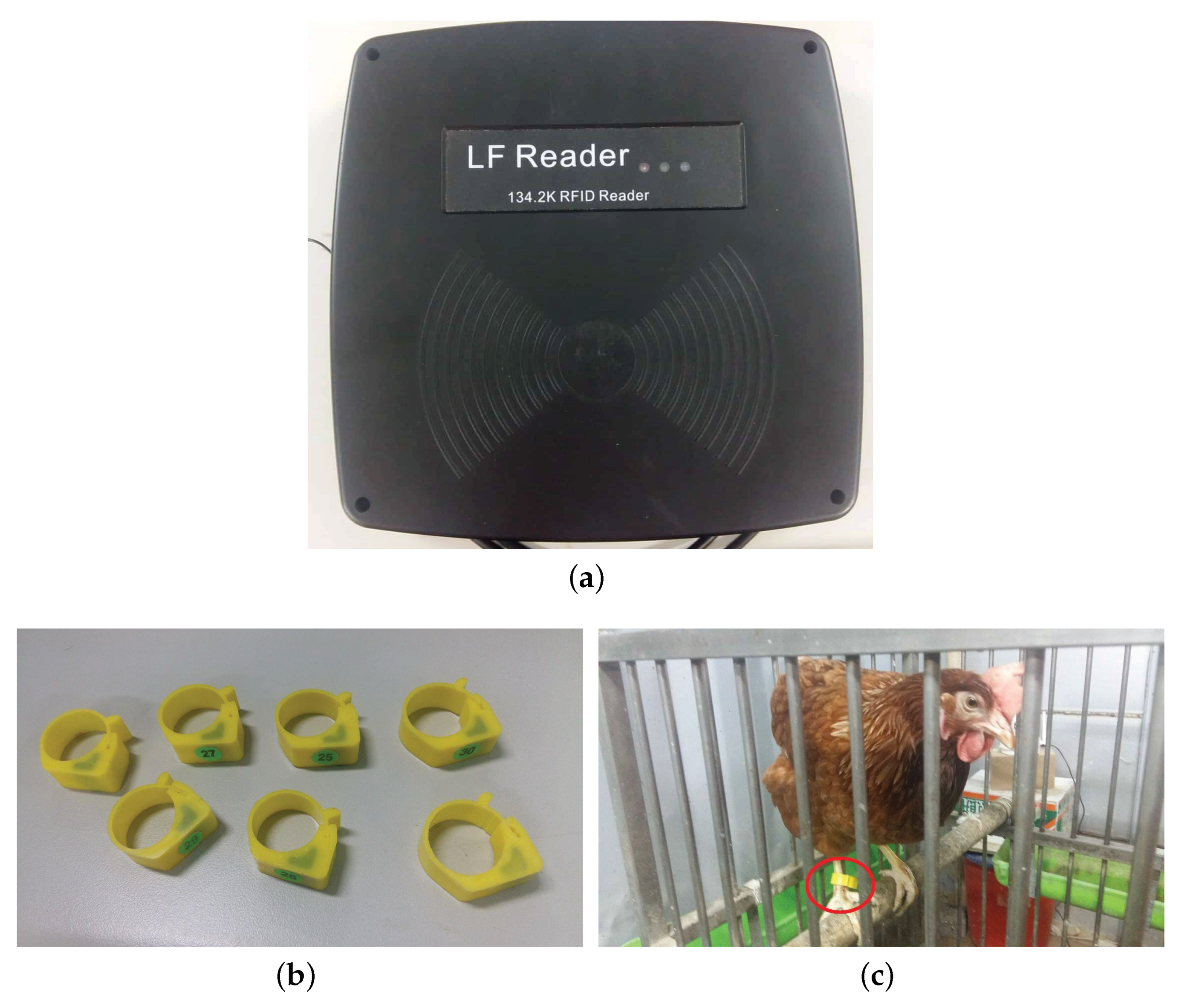
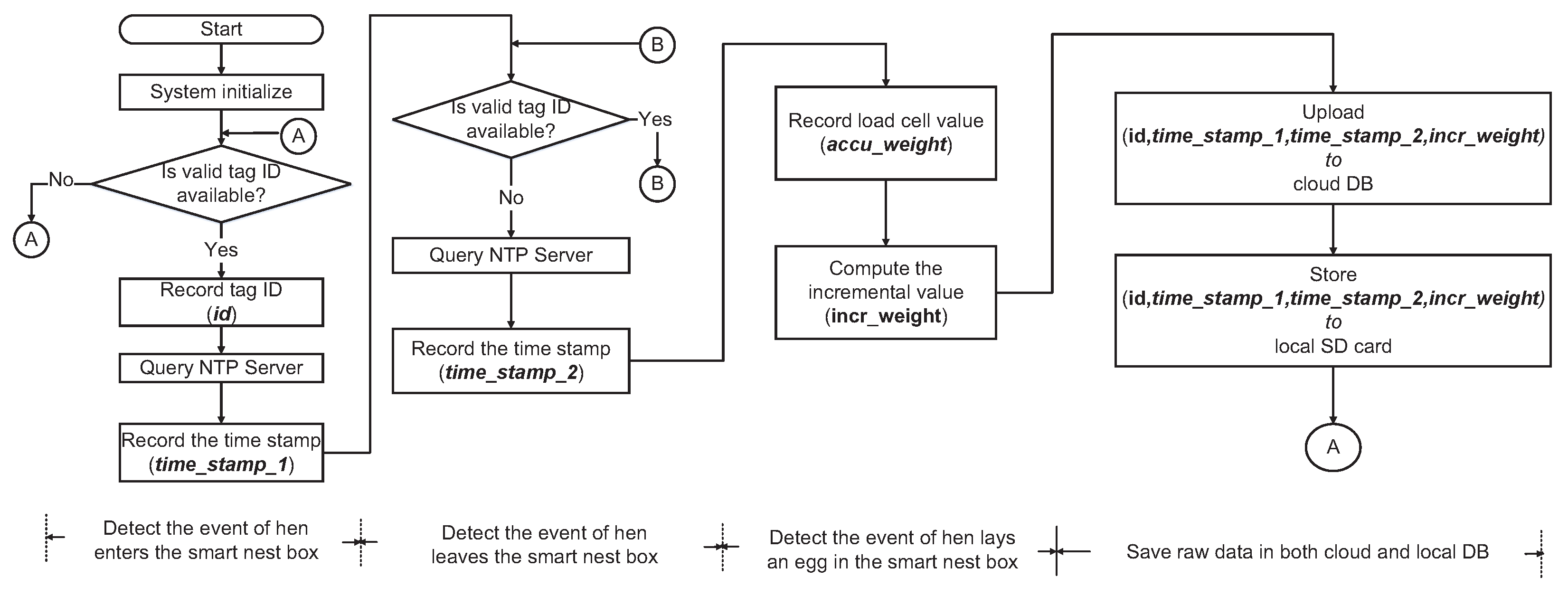

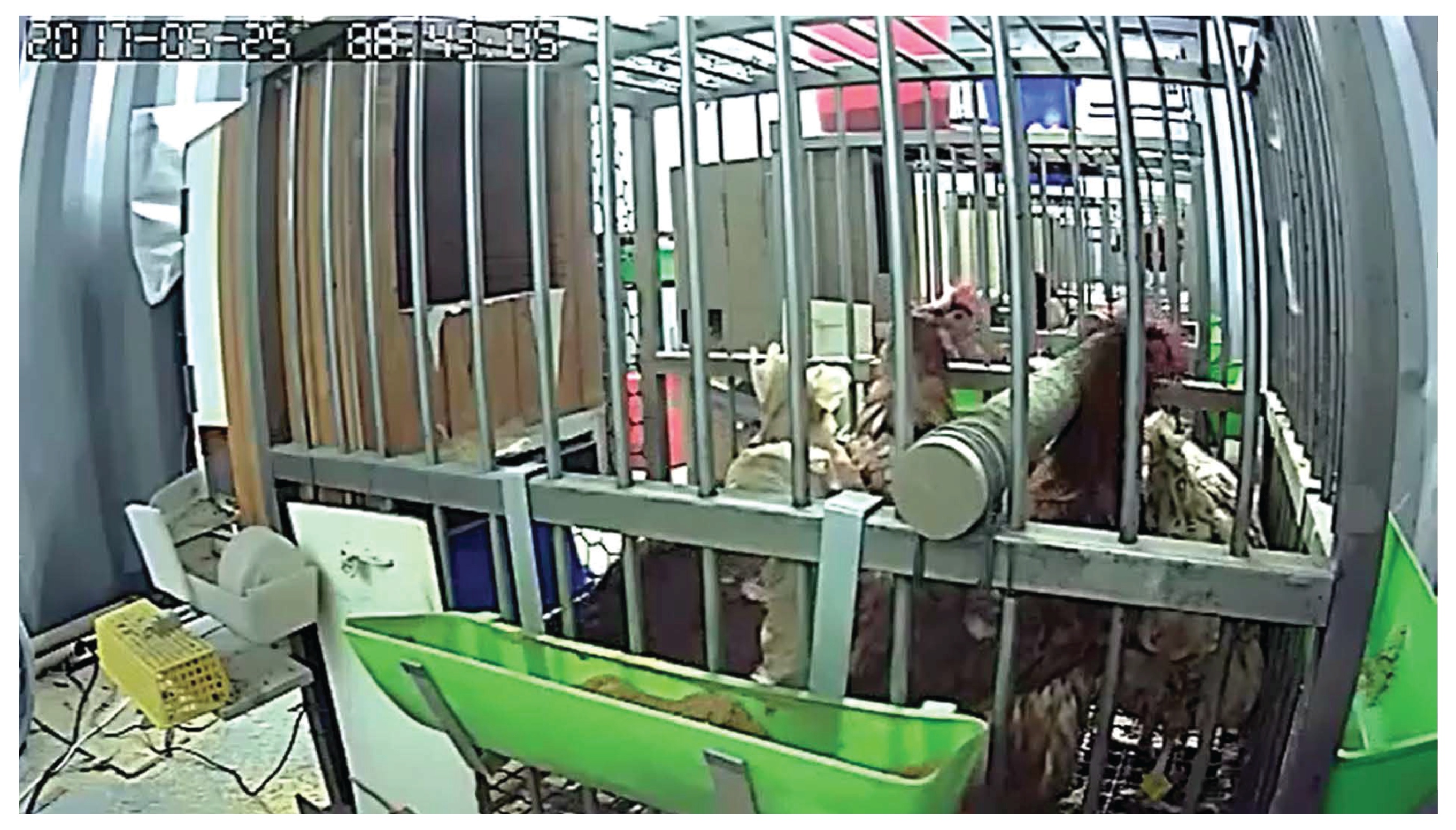
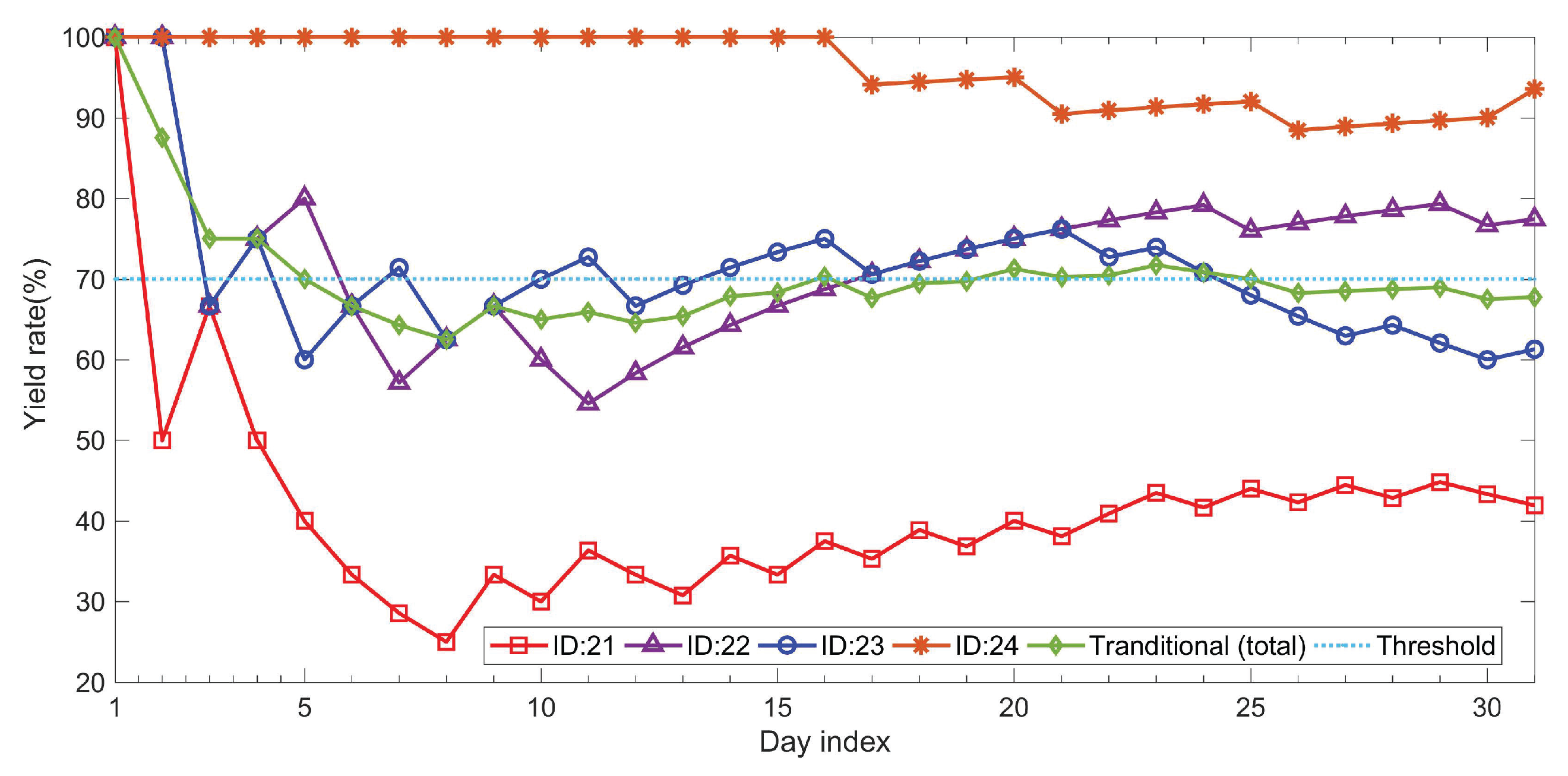
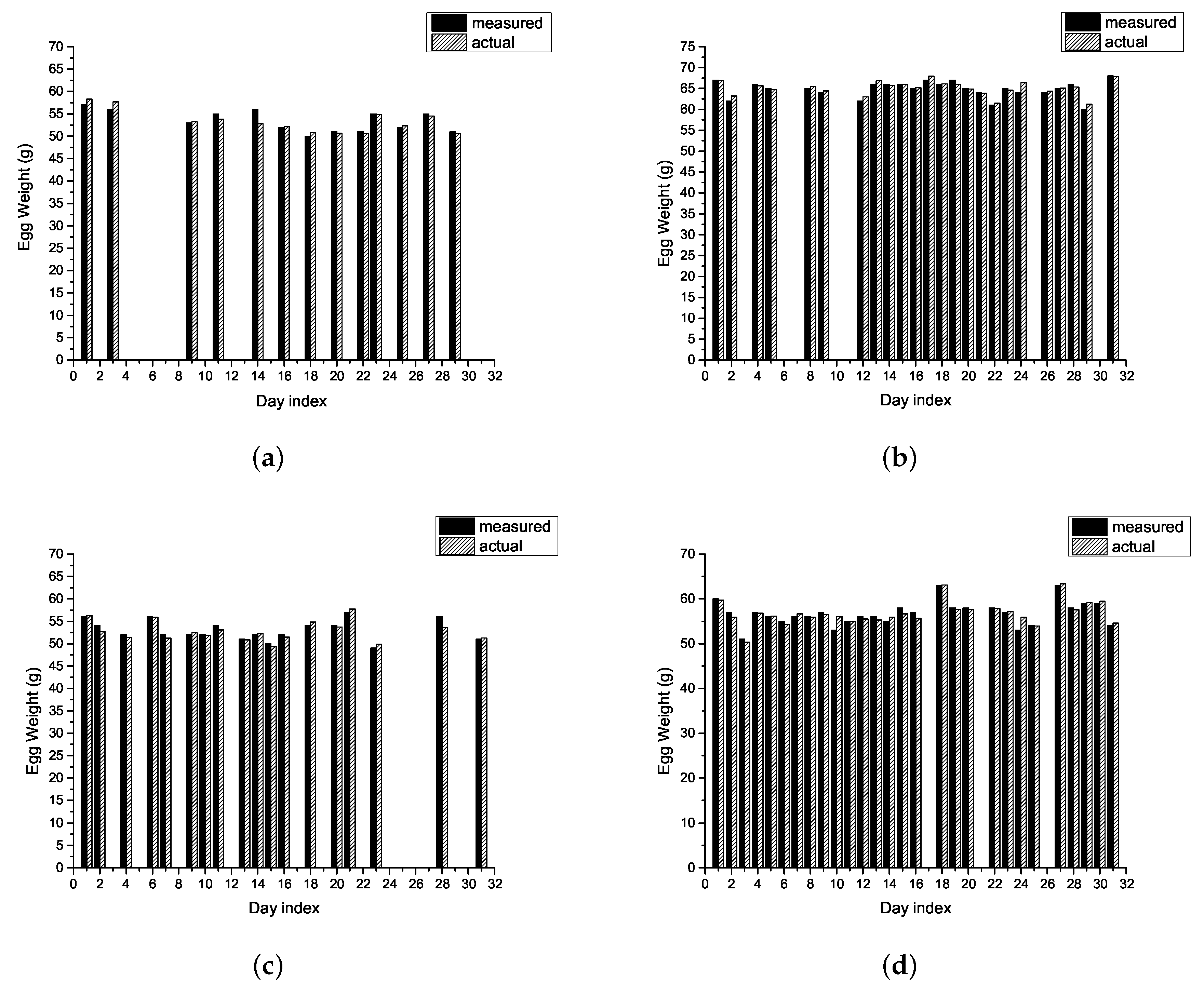


| Day Index | 1 | 2 | 3 | 4 | 5 | 6 | 7 | 8 | 9 | 10 | 11 | 12 | 13 | 14 | 15 | |
| ID: 21 | 1 | 0 | 1 | 0 | 0 | 0 | 0 | 0 | 1 | 0 | 1 | 0 | 0 | 1 | 0 | |
| ID: 22 | 1 | 1 | 0 | 1 | 1 | 0 | 0 | 1 | 1 | 0 | 0 | 1 | 1 | 1 | 1 | |
| ID: 23 | 1 | 1 | 0 | 1 | 0 | 1 | 1 | 0 | 1 | 1 | 1 | 0 | 1 | 1 | 1 | |
| ID: 24 | 1 | 1 | 1 | 1 | 1 | 1 | 1 | 1 | 1 | 1 | 1 | 1 | 1 | 1 | 1 | |
| Total | 4 | 3 | 2 | 3 | 2 | 2 | 2 | 2 | 4 | 2 | 3 | 2 | 3 | 4 | 3 | |
| Day Index | 16 | 17 | 18 | 19 | 20 | 21 | 22 | 23 | 24 | 25 | 26 | 27 | 28 | 29 | 30 | 31 |
| ID: 21 | 1 | 0 | 1 | 0 | 1 | 0 | 1 | 1 | 0 | 1 | 0 | 1 | 0 | 1 | 0 | 0 |
| ID: 22 | 1 | 1 | 1 | 1 | 1 | 1 | 1 | 1 | 1 | 0 | 1 | 1 | 1 | 1 | 0 | 1 |
| ID: 23 | 1 | 0 | 1 | 1 | 1 | 1 | 0 | 1 | 0 | 0 | 0 | 0 | 1 | 0 | 0 | 1 |
| ID: 24 | 1 | 0 | 1 | 1 | 1 | 0 | 1 | 1 | 1 | 1 | 0 | 1 | 1 | 1 | 1 | 1 |
| Total | 4 | 1 | 4 | 3 | 4 | 2 | 3 | 4 | 2 | 2 | 1 | 3 | 3 | 3 | 1 | 3 |
| Hen ID | (%) | ||
|---|---|---|---|
| 21 | 27 | 13 | 32.50% |
| 22 | 25 | 24 | 48.98% |
| 23 | 20 | 19 | 48.72% |
| 24 | 18 | 28 | 60.87% |
© 2018 by the authors. Licensee MDPI, Basel, Switzerland. This article is an open access article distributed under the terms and conditions of the Creative Commons Attribution (CC BY) license (http://creativecommons.org/licenses/by/4.0/).
Share and Cite
Chien, Y.-R.; Chen, Y.-X. An RFID-Based Smart Nest Box: An Experimental Study of Laying Performance and Behavior of Individual Hens. Sensors 2018, 18, 859. https://doi.org/10.3390/s18030859
Chien Y-R, Chen Y-X. An RFID-Based Smart Nest Box: An Experimental Study of Laying Performance and Behavior of Individual Hens. Sensors. 2018; 18(3):859. https://doi.org/10.3390/s18030859
Chicago/Turabian StyleChien, Ying-Ren, and Yu-Xian Chen. 2018. "An RFID-Based Smart Nest Box: An Experimental Study of Laying Performance and Behavior of Individual Hens" Sensors 18, no. 3: 859. https://doi.org/10.3390/s18030859





